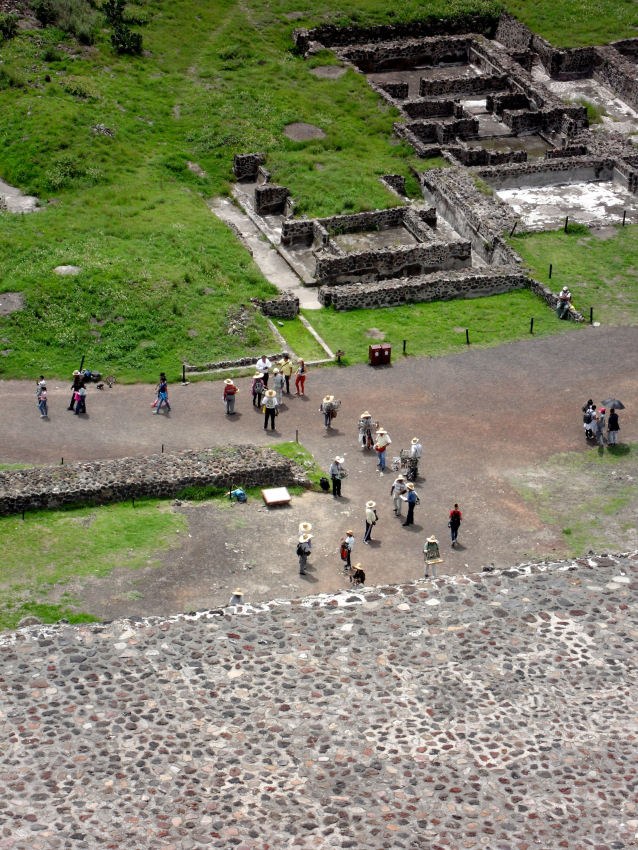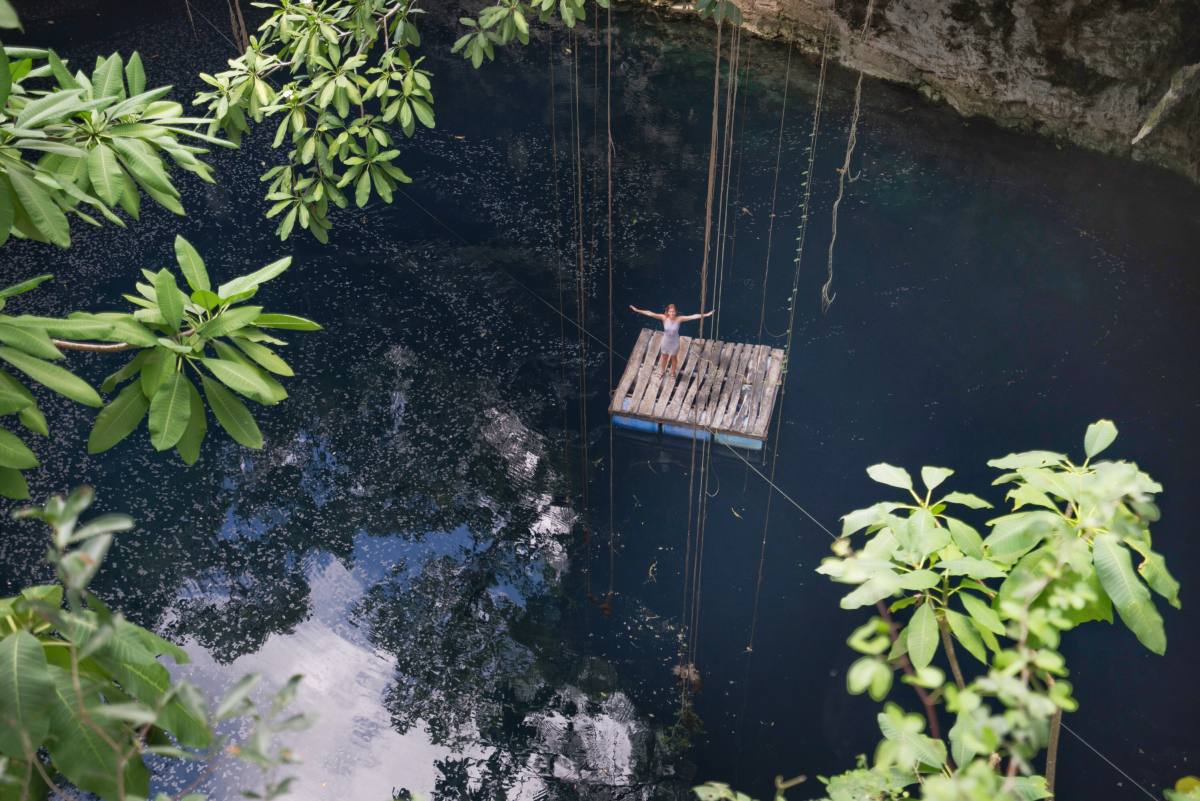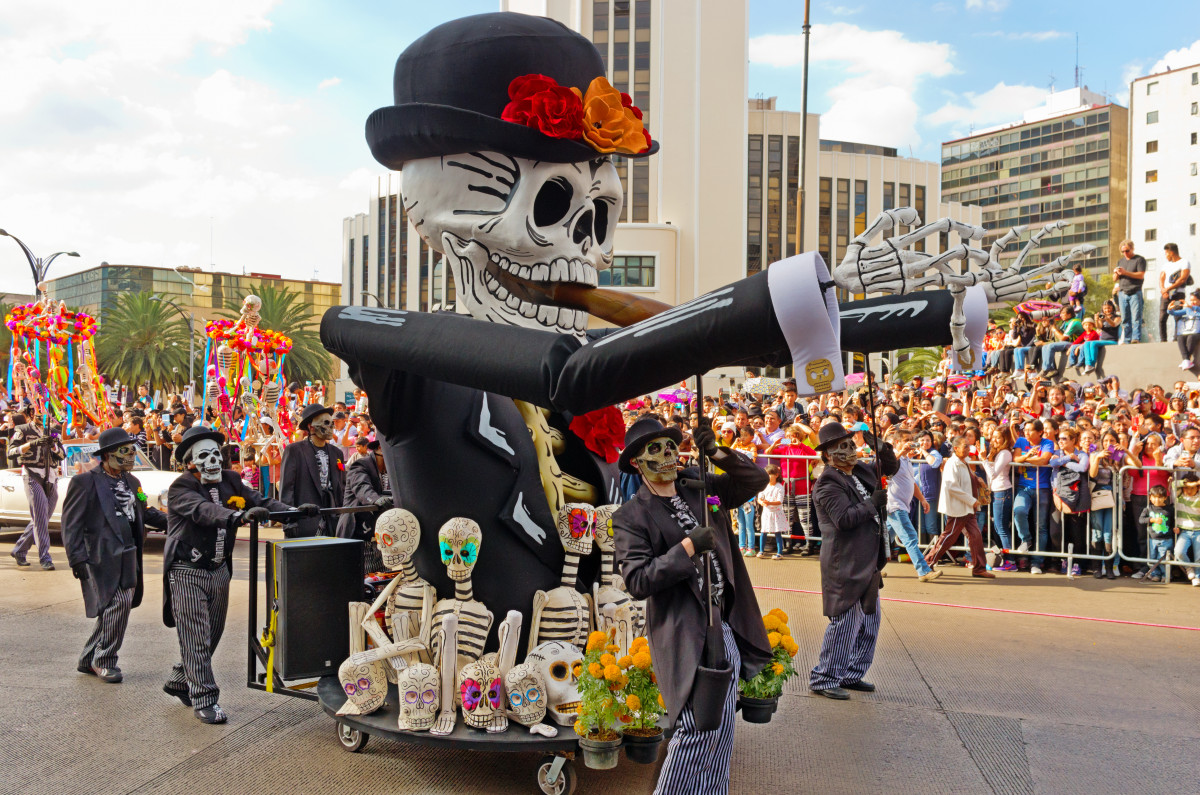Ultimate Guide to Visiting the Teotihuacan Pyramids
The great Pyramids of Teotihuacan rise just 25 miles outside of modern-day Mexico City. In the shadow of the dusty sierras, they crash above the towns and villages in a mighty show of Mesoamerican architecture. They have a history that goes back more than 2,000 years and are considered to be some of the most impressive relics of any kind in North America.
To put it simply, visiting these is a must for any history buff in CDMX! This guide runs through the story of the site – now marked with a UNESCO World Heritage tag – and details everything you need to know about planning your day…

Where are the Teotihuacan Pyramids?
The sprawling archaeological site at Teotihuacan sits a little over 14 miles away from the border between the State of Mexico and Hidalgo. It’s also just 25 miles to the northwest of downtown Mexico City itself.
The closest town is the small San Juan Teotihuacan. That’s the official modern municipality where the ancient sites are incorporated. It encompasses all of the gates to the historical wonders and has a bustling central plaza, a few shops, and a military base.
The history of the Pyramids at Teotihuacan
The real tale of the Pyramids at Teotihuacan continues to baffle historians. Big questions remain as to the peoples who inhabited these mighty structures, how powerful they were, what they believed in, and how their society operated. Lots can be gleaned from the sites themselves. Lots is still a mystery.
One thing’s for sure: Teotihuacan is unquestionably one of the most impressive historic sites in all of the Americas. It dwarfs other Mesoamerican complexes in Mexico, like the later Chichen Itza site on the Yucatan Peninsula. What’s more, it hosts some of the largest pyramids of the whole classical era.
It can be helpful to break it all down into separate stages, starting with the earliest days and the origins and ending with the fall of Teotihuacan, which seems to have occurred sometime around the 7th century AD.
The beginning of Teotihuacan (600 BC to 100 BC)
Evidence of human settlement in the Valley of Mexico (the geographical region where both Mexico City and Teotihuacan can be found) goes back to around the 6th century BC. However, it wasn’t until around 100 BC that the population of the area had reached a critical mass and a coherent urban unit was able to form. It’s thought that many of the local farmers moved to settle in the area around the natural springs that are known to exist on the site that was to become Teotihuacan.
The age of expansion (100 BC – 300 AD)
The city of Teotihuacan underwent extremely fast expansion for the next 400 years. A whole load of various factors worked to create massive population upswells. Disruptive volcanic eruptions in the Mexican mountains pushed villages into the settlement from the surrounding area. In addition, Teotihuacan offered the comfort of proper urban living for the first time, and the commerce that comes with a burgeoning economy.
This era is also marked by ambitious public building projects. Some of the most iconic Pyramids of Teotihuacan were raised at this time, including the stepped Temple of Quetzalcoatl, and – a little later again – the Pyramids of the Sun and Moon. These coincided with political upheavals that probably saw a shift from absolute monarchic rule to something more technocratic.
The golden age of Teotihuacan (300 AD – 650 AD)
After defining wars with Tikal – a major rival site that can be found in modern-day Guatemala – and excessive building projects alike, Teotihuacan emerged as the most powerful state in all of Mesoamerica by around the 4th century. Some estimations have it that over a quarter of a million people were living here after 450 AD, which would put Teotihuacan up there with the largest cities in the world at that time. In fact, the town itself had burst from the boundaries of the Avenue of the Dead and the pyramids and covered a whopping 11 square miles or more!
Decline of Teotihuacan (from 700 AD)
The decline of Teotihuacan is thought to have been caused by internal strife, possibly class revolution. That’s because there’s evidence of house burnings in the more upper-class parts of the city, particularly around the Pyramid of the Sun and the Avenue of the Dead. Either way, the population dropped, and local agriculture became unsustainable. However, the jaw-dropping structures still stood, and would go on to inspire other pre-Columbian civilizations such as the Maya and the Aztecs.

How to get to the Teotihuacan Pyramids
If you’ve gone for a private tour to the Teotihuacan Pyramids, the chances are you’ll have a pickup and a drop off at your hotel in Mexico City. If not, don’t worry. It’s super easy to reach these great ancient structures by public transport.
The first step is to get to the bus station. In Teotihuacan’s case that’s the Terminal de Autobuses del Norte, also known as just the North Terminal. Unsurprisingly, it’s located on the north side of the Mexican capital, in the area of Magdalena de las Salinas.
There are two ways to get to the terminal itself. Either ride the yellow line of the CDMX metro system to Autobuses del Norte. That’s easy from the airport, but involves a couple of changes if you’re starting out in the popular La Condesa or Roma areas. Tickets cost a mere 5 MXN per journey.
Alternatively, you can Uber this part of the trip. That’ll take around 25 minutes from the downtown area to the bus terminal.
At the station, you’ll need to get your ticket from the booth before making for the platform. This part’s important. You want the Teotihuacan bus that goes to ‘Los Piramides’, not the one for Teotihuacan town. Be sure to ask for the first and double-check with the driver when you board, otherwise you’ll end up a hefty walk from the historic sites. If you don’t speak Spanish, make up a triangle shape with your hands to get your point across.
We’d also recommend doing all this nice and early. Teotihuacan is one of the top day trips from Mexico City, and there are often snaking queues at the ticket offices. One-way journeys cost around 50 MXN.

How much does Teotihuacan cost?
The trip to Teotihuacan itself should cost around 120 MXN in total. That includes return bus tickets and metro transfers to and from the area around your hotel. On top of that, you’ll need to factor in the price of admission to the site. It’s not expensive – around 75 MXN per person, with access to the on-site museum, included.
Of course, you can book a day trip instead and you can pay anywhere from 800 to 1000 MXN. If you want to save time, and have the comfort of being picked up and dropped off at Mexico City, these guided trips are worth it. Many of them also include stops at the Basilica of Our Lady of Guadalupe, Plaza de las Tres Culturas, and food tastings.
There’s also an option of a trip to appreciate the magnificence of Teotihuacan from a hot air balloon. It’s so worth it!

Things to see at Teotihuacan
You won’t be short on things to see in Teotihuacan. Seriously, the moment you step into this vast UNESCO World Heritage Site, you’ll be greeted by soaring pyramids and mystical Mesoamerican structures. Some of the most important are…
Avenue of the Dead
This is the great thoroughfare that connects the whole city of Teotihuacan. In total, the Avenue of the Dead runs for 1.5 miles from top to bottom. It’s capped off by the Pyramid of the Moon and joins to the vast complexes of the Temple of Quetzalcoatl on its far end. It’s a great place to begin your tour of the site, as you stroll past the remains of huge platforms, shrines, and residential complexes.
Pyramid of the Sun
Wow! Seriously, this one’s a gasp inducer, a jaw-dropper. Up there with the largest pyramids of any type in the Americas (and even the world!), it clocks up a height of 75 meters from ground to top.
The impressive structure is thought to have been built during the Teotihuacan years of expansion, sometime around 200 AD. Little is known about its purpose, but theories suggest it venerated a particular Teotihuacano demigod.
Visitors can still scale the steps to get to the lookout points on the pinnacle. It takes around 15 minutes to get up there.

Pyramid of the Moon
The second-largest of the Pyramids of Teotihuacan, the Pyramid of the Moon seems to occupy a more focal point on the Avenue of the Dead. It was completed sometime before 450 AD, and is thought to represent a human copy of the rugged Cerro Gordo mountain that rises just behind.
It’s still possible to climb the Pyramid of the Moon. It’s much smaller than the sun pyramid, standing at 45 meters up. Something to remember as you climb: The Pyramid of the Moon was almost certainly a site of ritual sacrifice. The remains of snakes, cats, and even humans have been recovered from the ceremonial pits below!
Temple of Quetzalcoatl
The Temple of Quetzalcoatl is the third-largest but also the oldest of the Teotihuacan Pyramids, located towards the southern end of the site. Historians believe it was the original center of the Teotihuacan religion, but lost some of its importance after political power struggles in the 2nd century AD.
Archaeologists say it’s one of the first shrines of any in the pre-Columbian Americas to depict the revered Feathered Serpent god, which would go on to become pivotal to the Aztec civilization in later centuries.
The temple is also shrouded in a darker past, as evidence of more than 100 skeletons was discovered in the tombs below, indicating that it was a prolific center of human sacrifice.
Plaza del Sol
One of the main entry points to the site at Teotihuacan opens onto the Plaza del Sol. We can’t think of anywhere better to appreciate the sheer majesty and stature of these ancient structures. The Pyramid of the Sun and its 250 steps towers right overhead. The Pyramid of the Moon is visible to the north, via the Avenue of the Dead.
More than anything, this square gives you the chance to imagine bustling life in the old city, when merchants and priests and people would have been all around.
Recommended Guided Trips (especially if you like asking questions)
- Private guided tour to Tlatelolco, Teotihuacan and the Basilica of Guadalupe
- Teotihuacan and Tlatelolco Day Trip by Van
- Early Access to Teotihuacan followed by a Tequila tasting workshop
- Appreciate the magnificence of Teotihuacan from a hot air balloon
Tips for visiting the Teotihuacan Pyramids
- Go early – Just like in all the big UNESCO sites around the globe, from the Taj Mahal to Angkor Wat, getting in early is the way to beat the crowds. It’s also a good way to get a seat on a bus to the Teotihuacan Pyramids without having to wait!
- Take plenty of water – You can buy water at loads of stalls and shops just outside the Teotihuacan site, but there’s virtually nowhere to top up once you’re on the Avenue of the Dead or climbing the pyramids themselves. So, be sure to take enough to get you through a long day of walking!
- Wear a hat – The sun can be really strong in Teotihuacan. This is a pretty exposed part of the Valley of Mexico, too, so there’s not often shade to cool off in. A hat can work wonders, especially a good booney hat with UPF protection.
- Know your limits – This is Mexico, so it’s scorching. What’s more, the Pyramids of Teotihuacan sit at 7,400 feet above sea level, which means oxygen can be thin in the air. These aren’t ideal conditions to be lumping up over 200 steps to the top of ancient pyramids, especially on weathered stone staircases! Know your limits and stick to them.

Where to Eat near the Teotihuacan Pyramids
There’s a chance that your organized tour to Teotihuacan will include lunch. If not, or if you’re planning your own trip, there are a few spots worth having on the radar for topping up the energy levels before (or after) scaling the Pyramid of the Sun…
- El Ranchito – Yes, it’s touristy, but it’s fun. This casual Mexican eatery has a huge menu of enchiladas, salads, and mole sauces. It’s also super close to Gate 2 of the archaeological site, where the buses from Mexico City arrive.
- Restaurante las Piramides – Actually located inside the complex of the pyramids, this one sits in upstairs of the Gate 1 building. It’s convenient because that’s where most people finish their visit. The view from the tables is pretty cracking, too – it’s right over the haunting Temple of Quetzalcoatl.
- La Gruta – If you’re up for a short walk from the Teotihuacan complex, then be sure to mark La Gruta on the map. It sits a couple of minutes from the less-popular eastern exit. The detour is worth it though because you’ll get to dine on fiery Mexican food in a deep underground cave!

Where to stay near the Teotihuacan Pyramids
Most visitors to Teotihuacan stay in Mexico City and travel from there. However, there are also options to stay closer to the San Juan Teotihuacan area. Here are a few options in both locations.
San Juan Teotihuacan Hotels
- Hotel Casa de la Luna – budget-friendly family hotel
- Hotel Quetzalcalli – Simple clean hotel that’s easy on the pocket
- Hotel Quinto Sol – Four-star hotel with massive rooms
Mexico City Hotels
- Gran Hotel Ciudad de Mexico – Luxurious 5-star with historic architecture
- Zocalo Central – 1890’s-era building in the heart of Mexico City
- Hotel Principal – Budget-friendly hotel in City Centre
For more choices, read my guide on where to stay in Mexico City.
So that’s all you need to know about visiting the UNESCO heritage Teotihuacan Pyramid complex in Mexico City. Comment below if you have questions!






